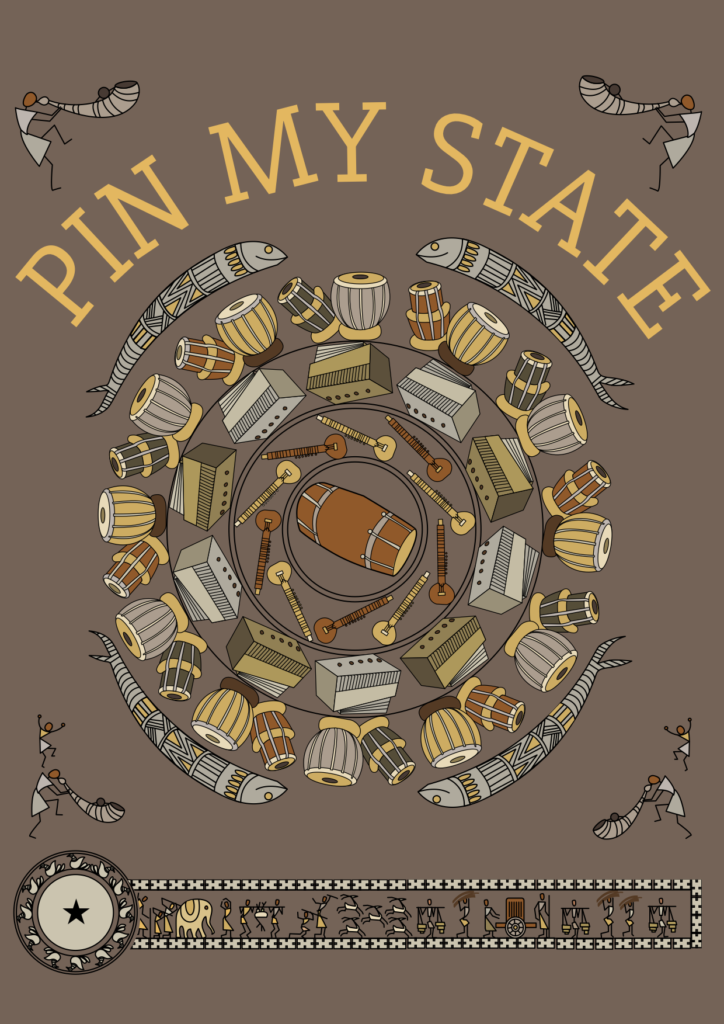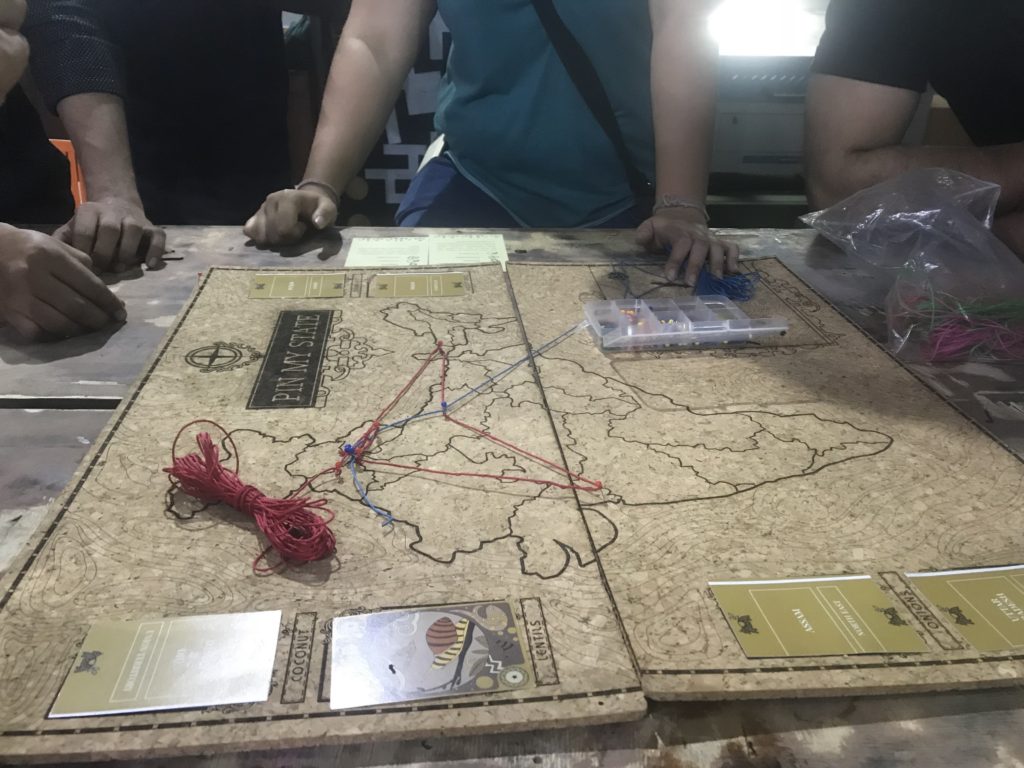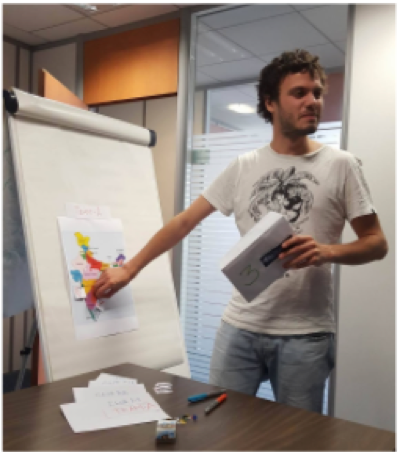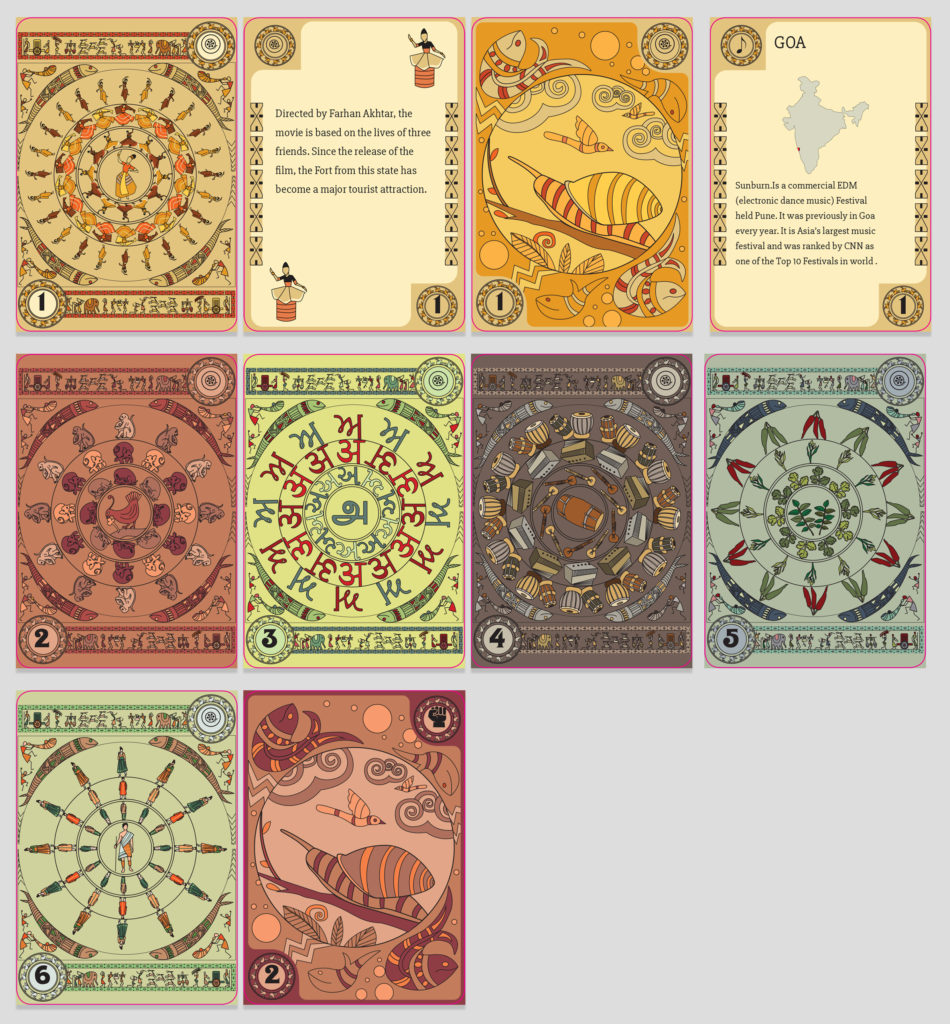Pin My State is a simple and fast trivia game to learn about the wealth of diversity between the many states and territories of India.
In the game, each team competes to answer trivia questions related to an Indian state or union territory, on subjects like movies, politics, literature, food, and others. As they answer correctly, they gain ingredients for their recipes, and get to place pins of their color into the cork playing board, which they later tie together with thread.
Within a workshop, Pin My State can be used to challenge stereotypes about the character of people from each state. It also serves as a means for the group to discover what geographical diversity is present within the group, and what is missing.
All components and assets for Pin My State are available on its GitHub repository.
History
Version 1
In the first version, Pin My State was meant to show that people from certain regions don’t obey the stereotypes of that place. Two teams take turns reading clues about a celebrity, the identity of which is not revealed. Their goal is to identify where in India, geographically speaking, the person is from.
For more information, you can read the README PinMyState v1. The clues cards can be printed out from PinMyState – Game content. Read about the inspiration for Pin My State on the original blog post announcing its release.
The game was initially based exclusively on stereotypes. It was interesting to notice how resistant people were to the realization that they had misjudged based on a stereotype. During the play testing players felt that the game was unfair and “made-up”.
Version 2
The objective was to use general characteristics of the state which have formed into stereotypes. However, an individual celebrity may not necessarily represent the stereotype. In a second version of the game, the clues were no longer about a person coming from a particular region, but rather about the state itself.
To play this version, download and print out PinMyState – Game content v2.
Version 2 of Pin My State was tested by ZMQ in workshops in India. Overall, players felt engaged and that they had learned about diversity. However players complained that the clues were far too difficult, or misleading.
Version 3
A new graphic design was created for the game cards. Each card back represents a different aspect of diversity within India.
Symbolism in the design of the cards
India is a complex country with diversity in various fields : culture, language, costumes, geography, music, food etc. Because Pin My State is a game through which the players learn and discovers various specificities of a state, the cards had to depict that.
Card 1 – Various traditional dance forms : Kathak, Bharatnatyam, Rajasthani folk dance , Mohni attam. Dances from various states of India.
Card 2 – Due to India’s diverse climatic conditions, one can find rich bio-diversity. From asian elephants, rhinos, to different types of deers, monkeys and birds.
Card 3 – Script. India has 16 official languages and numerus dialects. Each language has it’s own script. Varying from Devnagiri to Gurmukhi, Dravidian etc. To depicit the richness of these scripts, the letter A is portrayed in these various scripts.
Card 4 – Music. Music plays an important role in the lives and culture of Indians. In India there are 2 major music styles: Hindustani (North India) and Carnatic (South India). They use various instruments like tabla, veena, harmonium, dholak etc..
Card 5 – Spices. India is known for it’s spices and Kerala exports pepper all over the world. Card 5 gives a small glimpse of typical spices used in cuisine such as coriander, ginger, curry leaves, etc.
Card 6 – Costumes. Each state of India has it’s own traditional way of tying the saree for the women and dhoti kurta for the men. India has been influenced by islamic culture during the Moghul rule and western style clothing during the British colonisation.
The Symbolism of the Snail story
The answer cards were designed specifically to bring in “the spirit of India.” The snail carries quite a lot of symbolism:
1) Cycle of life, death and rebirth. The snail shell is a spiral (golden ratio) and in it one can see the very essence of the universe .
2) Snails have 2 types of slime. One type of slime for overcoming the obstacles like pebbles, vegetation, etc.. which symbolises that India keep moving ahead, irrespective of all the problems facing it such as poverty, overpopulation, and illiteracy. The second kind of slime is for protecting the tender bodies of the snails. This symbolizes that India has been successful in retaining its integrity and values, despite the challenges of globalisation and modernisation.
3) Snails are hermaphrodites. A hermaphrodite is an organism that has both male and female reproductive organs .It is like if the snails were male and female at the same time. This corresponds to Yoni and Linga philosphy. Yoni representing Shakti and Linga representing Shiva. Their union represents the eternal process of creation and regeneration, the union of male and female principles, and all existence.
Version 4
Perhaps the biggest change for this version of the game is the number and variety of clues. We decided to group the clues into a small set of categories for each state. There were two reasons: it gives players the opportunity to pick categories that they are comfortable with, and it shows that each area has its share of interesting culture.
Over 250 trivia questions were created for this version of the game, covering every state and union territory within India.
We also paid close attention to the graphical aspect of the game. We cut a game board out of cork to show the state boundaries in India. As players answer questions correctly, they put pins of their color into the board. They tie these pins together with thread of their color. The thread aspect allows them to track their progress and also serves as a nice metaphor for the cultural links that tie the country together.
Credits
The original prototype was created by Gayathri Gopalakrishnan. The following versions were made by Radhika Beaume (art) and Jesse Himmelstein (design). The trivia questions were researched and written by Ameya Murukutla.




